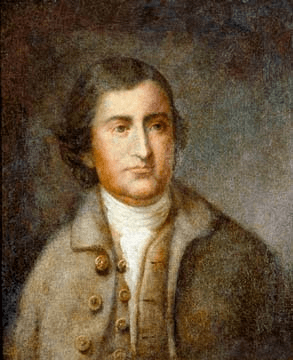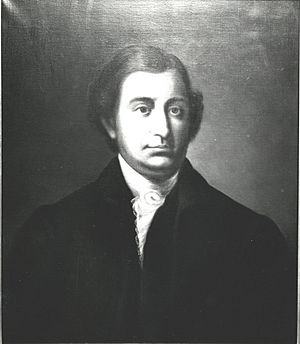Edmund Randolph facts for kids
Quick facts for kids
Edmund Randolph
|
|
|---|---|
 |
|
| 2nd United States Secretary of State | |
| In office January 2, 1794 – August 20, 1795 |
|
| President | George Washington |
| Preceded by | Thomas Jefferson |
| Succeeded by | Timothy Pickering |
| 1st United States Attorney General | |
| In office September 26, 1789 – January 26, 1794 |
|
| President | George Washington |
| Preceded by | Position established |
| Succeeded by | William Bradford |
| 7th Governor of Virginia | |
| In office December 1, 1786 – December 1, 1788 |
|
| Preceded by | Patrick Henry |
| Succeeded by | Beverley Randolph |
| 1st Attorney General of Virginia | |
| In office July 4, 1776 – November 30, 1786 |
|
| Preceded by | John Randolph (For Colonial Virginia) |
| Succeeded by | James Innes |
| Personal details | |
| Born |
Edmund Jennings Randolph
August 10, 1753 Williamsburg, Virginia, British America |
| Died | September 12, 1813 (aged 60) Millwood, Virginia, U.S. |
| Political party | Federalist |
| Spouse | Elizabeth Nicholas |
| Children |
|
| Relatives | John Randolph (Father) |
| Education | College of William and Mary (BA) |
| Signature | |
Edmund Jennings Randolph (born August 10, 1753 – died September 12, 1813) was an important person in early American history. He was one of the Founding Fathers. He worked as a lawyer and served as the 7th Governor of Virginia.
Randolph was a delegate from Virginia at the Constitutional Convention. He helped create the U.S. Constitution. Later, George Washington chose him to be the first United States Attorney General. He also served as the second Secretary of State.
Contents
Early Life and Family
Edmund Randolph was born on August 10, 1753, in Williamsburg. His family, the Randolphs, was very influential in the Colony of Virginia. He went to the College of William and Mary.
After college, he studied law with his father, John Randolph, and his uncle, Peyton Randolph. In 1775, when the American Revolution began, his father stayed loyal to Britain and moved there. Edmund Randolph, however, returned to America. He joined the Continental Army and became an aide-de-camp to General George Washington.
In October 1775, his uncle Peyton Randolph passed away. Edmund went back to Virginia to handle his uncle's estate. While there, he was chosen as a representative to the Fourth Virginia Convention. He later became the mayor of Williamsburg. Then, he served as the attorney general of Virginia until 1786.
On August 29, 1776, he married Elizabeth Nicholas. She was the daughter of Robert C. Nicholas. They had six children together. One of their children was Peyton Randolph, who later became Governor of Virginia.
Political Career
Serving in Congress and as Governor
In 1779, Randolph was chosen as one of 11 delegates to represent Virginia. He served in the Continental Congress until 1782. During this time, he also worked as a private lawyer. He handled many legal cases for important people like George Washington.
In 1786, Randolph was elected as the Governor of Virginia. That same year, he attended the Annapolis Convention. He had a young student and law partner named John Marshall. When Randolph became governor, he gave his law practice to Marshall. This was because Virginia law did not allow executive officers to practice law in court.
The Constitutional Convention

The next year, Randolph was a delegate from Virginia to the Constitutional Convention. He was 34 years old. He introduced the Virginia Plan, which was a first idea for a new national government. He spoke against the importation of enslaved people. He also wanted a strong central government.
His plan suggested having three chief executives from different parts of the country. The Virginia Plan also proposed a legislature with two parts (bicameral). Delegates for both parts would be chosen based on each state's population. Randolph also suggested creating a national court system. This idea was supported by everyone at the convention. The earlier Articles of Confederation did not have a national court system.
Randolph was also part of the "Committee of Detail." This committee was in charge of turning the Virginia Plan's ideas into the first draft of the Constitution.
However, Randolph chose not to sign the final document. He was one of only three members at the convention who refused to sign. The others were George Mason and Elbridge Gerry. Randolph felt the final document did not have enough checks and balances. He also thought the federal court system might threaten state courts. He believed the Senate was too powerful and Congress had too much power. He also wanted a way for the states to review the Constitution again before it was fully adopted.
Role in Ratification
Even though he didn't sign the Constitution, Randolph played a big part in its creation. He helped propose the Virginia Plan. This plan was later changed and became the final U.S. Constitution. He didn't sign it because he wanted more protections for people. He also disagreed with some changes made to the original Virginia Plan.
Virginia Convention
Despite his earlier concerns, Randolph changed his mind at the Virginia Ratifying Convention in 1788. He led this convention, which was almost evenly divided. George Mason, who was against the Constitution, was very upset by Randolph's change of heart. Mason and others wanted changes to the Constitution before it was approved.
Randolph explained that it would be easier to change the Constitution before it was approved. He said it would be harder to get three-fourths of the states to agree to changes later. He believed people should not get used to changing their constitution often once it was adopted.
Governor Randolph had written that if changes could not be made, he would accept the Constitution as it was. He eventually voted for the Constitution. By June 2, eight other states had already approved it. He did not want Virginia to be left out of the new national government. Randolph believed Virginia had to choose between approving the Constitution or being separate from the other states. He always believed in the benefits of the union.
At the Richmond Ratification Convention, Randolph helped Virginia's leaders accept the Constitution. He told them that the Constitution they were approving would not be too powerful. He said it would be more like a group of independent states than a single, combined union.
Randolph wrote that his actions convinced five delegates who were undecided to vote for approval. In the end, Virginia approved the Constitution by exactly five votes.
Serving in Washington's Cabinet
President Washington rewarded Randolph for his support. In September 1789, Randolph was appointed as the first U.S. Attorney General. He tried to stay neutral in the disagreements between Thomas Jefferson and Alexander Hamilton. Randolph was a second cousin to Jefferson. In Washington's cabinet, Randolph tried to bring people together. He wanted to avoid quick decisions and focus on what was best for the new nation. He helped shape the new nation and its relationship with the states.
When Jefferson resigned as Secretary of State in 1793, Randolph took his place. A main goal during his time was the Jay Treaty with Britain in 1794. However, Hamilton planned this treaty and wrote the instructions. Randolph mostly had the smaller job of signing the papers. Randolph did not like the treaty. He almost convinced Washington to reject it. But then the Fauchet scandal happened, and his advice was ignored. Near the end of his time as Secretary of State, negotiations for Pinckney's Treaty were completed.
Resignation from Secretary of State
In August 1795, Randolph resigned as Secretary of State due to a scandal. This scandal involved an intercepted French message. Randolph was supposed to keep good relations with France. The British Navy had intercepted letters from the French minister Joseph Fauchet. They gave these letters to Washington. Washington was upset because the letters showed disrespect for the United States. They also suggested that Randolph had shared secret cabinet discussions with France. The letters implied that Randolph told France the U.S. government was against them.
Washington immediately ignored Randolph's advice against the Jay Treaty. A few days later, Washington showed the minister's letter to Randolph in front of the entire cabinet. He demanded an explanation. Randolph was speechless and resigned right away. Historians believe France did not bribe Randolph. They describe him as a sad figure with some talents but prone to silly mistakes and poor judgment.
After he resigned, Randolph was held responsible for losing a large sum of money. This happened during his time as Secretary of State. He was eventually ordered to pay the government over $49,000. He paid this amount.
Later Life and Legacy
After leaving the federal government, Randolph returned to Virginia. He continued to practice law and became a leading lawyer in the state. His most famous case was defending Aaron Burr at his trial for treason in 1807.
In 1791, Randolph was chosen to be a member of the American Philosophical Society.
Randolph spent his final years living with his friend Nathaniel Burwell at Carter Hall. This was near Millwood, Virginia, in Clarke County. He suffered from paralysis in his last years. He passed away at age 60 on September 12, 1813. He is buried nearby at the Burwell family cemetery. This cemetery is next to "Old Chapel."
Randolph County, West Virginia was created in 1787 and named in his honor. Randolph County, Illinois was also named after him. Randolph was the governor of Virginia when the state gave up what was then called Illinois County, Virginia to the new federal government. This land became the Northwest Territory. Randolph County's motto is "where Illinois began." This is because it was one of the first two settled counties in the territory. It includes Kaskaskia, which was the first capital of Illinois Territory and later the state's first capital.
The Edmund J. Randolph Award is the highest award given by the US Department of Justice. It honors people who make "outstanding contributions to the accomplishments of the Department's mission."
Images for kids
See also
 In Spanish: Edmund Randolph para niños
In Spanish: Edmund Randolph para niños



